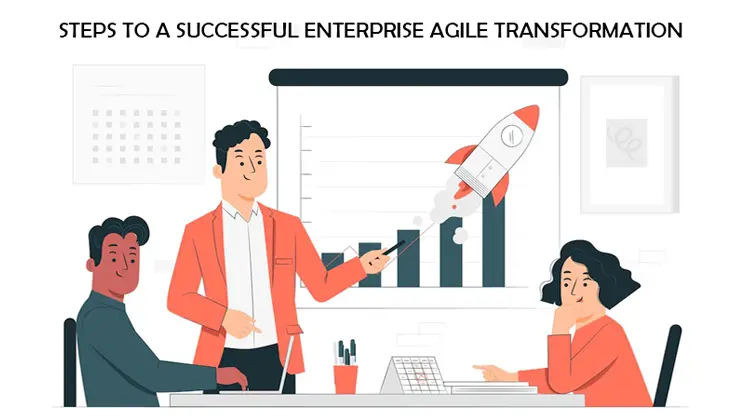The dictionary meaning of adjective “agile” means quick and well-coordinated in movement. So, Enterprise Agile Transformation is the ability to move quickly forward in a well-coordinated manner. This enterprise agility transformation is what makes an enterprise successful, adapt to unforeseen socio-economic changes, and withstand competition from various quarters in today’s world. But how to achieve successful agile transformation is the big question! If you observe all the enterprises that are old and still running successfully, you will notice one common thing for their successful run and that is adaptability. They adapted to various changes from time to time, withstood competition, bounced back in the shortest time during an unforeseen fall, and stood victorious! Enterprise Agile Transformation is not new to businesses, it was already there and is being followed by all the successful businesses all over the world for ages. Maybe, way back it was just called transformation. But why there is so much focus on agile transformation strategy only now? Because previously, socioeconomic development is rather slow and enterprises used to have enough time to respond, transform, and align their businesses to those changes. Enterprises that refused to forego their age-old legacy practices and procedures either suffered a slow death or struggled to keep up while the ones that have adapted to the winds of change, albeit slowly, are still running their business. But times have changed. The last decade has seen a rapid boom in socioeconomic growth due to immense development in all fields, particularly technology! The new technological innovations have led to cut-throat competition among various businesses which wasn’t seen before. Coupled with rapid changes in consumer behavior, most enterprises have no clue about how to face various disruptions that are impacting their businesses like rapid economic growth, evolving tech innovations, and changing consumer demands. At this juncture, the Enterprise Agile Transformation is born, or rather evolved from its previous predecessor! Every enterprise today, whether big or small, should have an agile transformation roadmap – no, not to be at the top like before, but even just to conduct day-to-day business because, such is the pace at which things are moving in the present modern world.
So, how does an enterprise approach the agile transformation strategy? One thing is sure, Enterprise Agile Transformation cannot be achieved overnight. It is not that easy to simply shed age-old rooted corporate practices, traditional work culture, workflow, and mindset. Enterprise agility transformation is not just about replacing your old business model with modern technology and processes but also about people, communication, and thinking. Successful agile transformation is an evolving journey and not a target to reach. Agile transformation strategy would be different for different enterprises, but the 4 most common steps that every enterprise needs to follow on the road to agile transformation are listed below.
Redefining organization structure:

The first step to a successful agile transformation is to redefine your old structures, strategies, and processes that are cumbersome, inflexible, and redundant. Enterprise agility transformation calls for sharing of information throughout the enterprise, to begin with. Most of the traditional, legacy companies follow a top-down, linear approach where the employees down the line have no clue what they are doing and why due to missing communication and lack of information.
The organizational hierarchy should be as flat as possible to eliminate middle management between top executives and frontline employees. This allows for faster communication and decisions. By reducing the levels of management and creating more functional teams, everyone in the organization knows their role and responsibility in the company. Google and Amazon are the best examples of flat organizations.
Redefining corporate culture and communication:
Enterprises should hold on to the teams, rather than just a few employees. Agile transformation strategy requires employees to shift their mindset and behavior from working in silos to working with cross-functional teams. This redefines corporate culture and accountability from individuals to teams and since the dependency on individuals is now shifted to teams, the show will go on in the absence/shift of a few members of the team. This corporate culture redefining results in employee collaboration, sharing of knowledge, and self-management.
The next important aspect of enterprise agility transformation is internal communication in an enterprise. Internal communication helps employees to understand what’s going on with the company, their purpose in the company, objectives, and goals. These communication channels are more important during Enterprise Agile Transformation as the employees will have various doubts about the things that are changing rapidly around them and clear, effective, and transparent communication from the employer will not only make their role clear in the project but also help them motivate to do their part effectively and align themselves with the enterprises’ goals.

Make use of current technology:

Technology plays an important role in Enterprise Agile Transformation. Knowing current technological trends and finding ways to harness, leverage, and imbibe them into your business model will definitely help in bringing agility to an enterprise. A case in point is during the covid-19 when the cash flow was rather slow or restricted, businesses particularly in India, are quick to move to digital payment modes like Paytm and Gpay taking advantage of the emerging technologies.
One of the important aspects of an agile transformation is how quickly an enterprise responds to a crisis, particularly when the crisis is sudden and unforeseen. During such a crisis as covid-19, even street vendors are quick to adopt digital payment methods so that their business is not affected by the nonavailability of hard cash. Even for the big corporates, technology helped a lot in bringing the office to employees’ homes through various technologies facilitating work from home.
Focus on consumers:
This is perhaps the most important step towards Enterprise Agile Transformation. Whatever product or service your enterprise is making or designing, it should be designed keeping the end-user, consumer, or customer in mind. There is a huge shift in customer psychology and expectations. In today’s digital world, customers not only demand a great experience through the products they are spending money on but also expect quick resolution of their queries and complaints.

Enterprises should be quick in altering a product that hasn’t met both the desired results of the maker and the requirement of the consumer or completely cease the production and replace it with renewed one that makes all parties i.e, maker and consumer, happy!
Whatever your enterprise is, the above 4 basic steps can help your firm become agile when incorporated into your agile transformation roadmap. Even for software companies that use sophisticated agile methodologies such as Scrum, Kanban, Extreme Programming XP, Lean Development, and Crystal, you can find these 4 steps incorporated into them in one form or another. The most common benefits of Enterprise Agile Transformation are as follows:
- Better and more transparent communication leads to a healthy culture in the workplace with empowered, self-organizing, and independent working employees.
- Production errors can be significantly reduced because of efficient collaboration and understanding between different cross-functional teams.
- Using the current emerging technologies can bring a product to the market much faster and in more flexible ways.
- Any changes to the product can be done without disturbing the entire product development cycle.
- Enterprises will be better equipped for any unforeseen circumstances driven by various factors such as social, economic, and natural changes or calamities.
Enterprise agility transformation looks good on paper and is easier said than done! Resistance to change, poor communication between different teams, lack of support from the top, and lack of proper knowledge in utilizing the technology at hand are the major obstacles in the path to Enterprise Agile Transformation .



